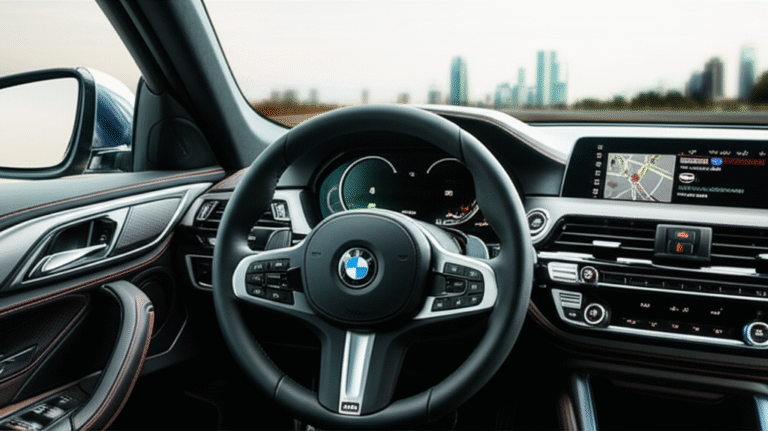BMW Car Back Side: 6 Shocking Designs
BMW car back side: 6 shocking designs you can’t miss. Discover the evolution and impact of BMW’s distinctive rear-end aesthetics.
Key Takeaways
Explore 6 distinct BMW car back designs.
Understand the impact of rear design on aerodynamics.
Learn how BMW’s rear styling evolved over decades.
Identify iconic taillight shapes and their meaning.
See how trunk lines define BMW models.
Appreciate the blend of luxury and sport in BMW rears.
The back of your BMW is more than just metal and lights; it’s a statement. Often overlooked, the BMW car back side tells a story of engineering, luxury, and evolving design. From the iconic Hofmeister Kink to the aggressive diffuser housings, these elements create a distinct visual identity that enthusiasts recognize instantly. Understanding these design choices can deepen your appreciation for the marque. Let’s dive into six shocking BMW car back side designs that have shaped automotive history and continue to influence today’s luxury vehicles.
Understanding the BMW Car Back Side: More Than Just a Trunk
The rear of a vehicle is a complex interplay of form and function. For a brand like BMW, known for its “Ultimate Driving Machine” ethos, the car back side is crucial. It houses essential components like the taillights, exhaust systems, and impact absorption structures, all while contributing significantly to the car’s overall aesthetic and aerodynamic performance. The way the trunk lid curves, the shape of the taillights, and the integration of the bumper all play a role in how the car is perceived and how efficiently it moves through the air. Aerodynamics, in particular, is a significant consideration, as a well-designed rear can reduce drag and improve fuel efficiency and stability at high speeds. This focus on detail is a hallmark of German engineering and a key reason why BMWs are so distinctive.
6 Shocking BMW Car Back Side Designs That Made Waves
BMW has consistently pushed the boundaries of automotive design, particularly at the rear of their vehicles. What might seem like minor tweaks to the untrained eye are often significant evolutions that define an era or a specific model’s character. These designs aren’t just about looking good; they are deeply rooted in the brand’s philosophy of combining sportiness with luxury and advanced engineering.
1. The Classic E92 M3: Aggression Meets Elegance
The E92 M3, produced from 2007 to 2013, represents a pinnacle of naturally aspirated performance and a rear design that perfectly encapsulates its dual nature. The broad, muscular fenders hint at the power beneath, while the subtle lip spoiler on the trunk lid adds a touch of racing pedigree. The quad exhaust tips, a signature of M performance models, are elegantly integrated into a sculpted rear bumper, promising a visceral auditory experience to match the visual drama. The taillights, with their sharp, angular lines, convey a sense of precision and speed. This design is a masterclass in balancing raw power with sophisticated styling, making the E92 M3’s rear a truly iconic sight.
Key Design Elements:
Quad Exhaust System: Immediately signals performance and athletic intent.
Subtle Trunk Lip Spoiler: Enhances aerodynamics and adds a sporty silhouette.
Sculpted Rear Bumper: Integrates exhaust and body lines seamlessly.
Angular Taillights: Modern and sharp, conveying precision.
This rear design is a key reason many consider the E92 M3 a modern classic. It’s a BMW car back side that many aspire to own.
2. The L-Shaped Taillights of the E39 5 Series: Sophistication Unveiled
The E39 5 Series (1995-2003) brought a new level of understated elegance to BMW’s sedan lineup, and its rear design was a significant part of that. The L-shaped taillights were a bold departure from previous designs, wrapping around the corners of the car and creating a wider, more planted visual impression. This distinctive shape became a BMW signature for years to come. The smooth, clean lines of the trunk lid and the integrated bumper contribute to a refined and timeless aesthetic. It’s a BMW car back side that speaks of mature luxury and engineering prowess, proving that impactful design doesn’t always need sharp edges.
Key Design Elements:
Iconic L-Shaped Taillights: Defined the rear and contributed to a wider appearance.
Smooth Trunk Lid: Emphasized cleanliness and elegance.
Integrated Rear Bumper: Maintained a cohesive and uncluttered look.
Subtle Chrome Accents: Added a touch of premium detailing.
The E39’s rear was a bold statement of BMW’s evolving design language, prioritizing flowing lines and sophisticated presence.
3. The Aggressive Stance of the F90 M5: Modern Powerhouse
The F90 M5 (2017-Present) takes the concept of a high-performance luxury sedan’s rear end to a new level. Its design is all about assertive power and cutting-edge technology. The wide rear track, emphasized by flared fenders, gives it a formidable presence. The slim, horizontal LED taillights create a sharp, modern signature that flows seamlessly into the bodywork. The rear diffuser is larger and more pronounced, hinting at the immense aerodynamic downforce this car can generate. The quad exhaust tips are integrated with purpose, appearing less as an add-on and more as an integral part of the car’s aggressive stance. This is a BMW car back side that doesn’t shy away from announcing its performance capabilities.
Key Design Elements:
Wide Rear Track: Visually emphasizes stability and power.
Slim, Horizontal LED Taillights: Modern, sharp, and technologically advanced.
Prominent Rear Diffuser: Suggests advanced aerodynamics and racing lineage.
Integrated Quad Exhaust: Functional and visually aggressive.
The F90 M5’s rear design exemplifies BMW’s commitment to blending extreme performance with sophisticated,
modern aesthetics.
4. The E60 M5’s Quad Exhaust and Angularity: A Bold Statement
The E60 M5 (2005-2010) was a technological marvel, especially with its high-revving V10 engine, and its rear design reflected this daring spirit. It moved away from the softer lines of its predecessors towards a more angular and aggressive look. The quad exhaust pipes were prominent, a clear signal of its M performance heritage. The taillights were sharp and modern for their time, featuring distinctive LED elements. The trunk lid often featured a subtle lip spoiler, enhancing its sporty silhouette. This BMW car back side was designed to be noticed, conveying a sense of potent energy and a departure from BMW’s more traditional styling.
Key Design Elements:
Prominent Quad Exhaust Pipes: A clear visual cue for a high-performance engine.
Angular Taillight Design: Modern for its era, conveying sharpness.
Sporty Trunk Lip Spoiler: Adds to the athletic profile and aerodynamic refinement.
Sculpted Rear Bumper: Accommodates exhaust and adds muscularity.
The E60 M5’s rear was a bold statement, signaling BMW’s willingness to experiment with more aggressive styling for its top-tier performance models.
5. The G30 5 Series: The Evolution of Elegance and Tech
The G30 5 Series (2017-Present) represents a sophisticated evolution of the BMW sedan’s rear. It refines the principles seen in the E39 and E60, integrating modern technology with classic elegance. The taillights are sleeker and more horizontally oriented than ever, often featuring intricate LED patterns that create a striking light signature at night. The overall design is clean and uncluttered, with smooth lines flowing from the roofline to the bumper. The exhaust outlets, while present, are often more subtly integrated, emphasizing the car’s luxurious nature over overt sportiness, though performance models offer a bolder execution. This BMW car back side balances technological advancement with a refined, premium feel.
Key Design Elements:
Sleek, Horizontal Taillights: Modern and technologically advanced light signatures.
Uncluttered Rear Design: Emphasizes cleanliness and premium aesthetics.
Subtle Exhaust Integration: Focuses on luxury and aerodynamic efficiency.
Flowing Body Lines: Creates a sense of motion and sophisticated dynamism.
The G30’s rear demonstrates how BMW continues to blend its heritage with the latest in automotive design and technology.
6. The Iconic E46 M3: Muscular Lines and Distinctive Exhaust
The E46 M3 (2000-2006) is celebrated for its pure driving experience, and its rear design perfectly complements its athletic prowess. It boasts a muscular and sculpted rear end, with flared wheel arches that give it a planted, aggressive stance. The distinctive quad exhaust tips are a signature element, exuding performance. The taillights, while not as dramatically shaped as some later models, are sharp and well-defined, contributing to the car’s purposeful look. The trunk lid is subtly sculpted, often featuring a small lip spoiler that enhances its aerodynamic profile. This BMW car back side is a perfect example of how functional design can also be incredibly attractive, embodying the M division’s blend of raw power and refined engineering.
Key Design Elements:
Muscular Rear Fender Flares: Visually widen the car and enhance its sporty stance.
Quad Exhaust Tips: Iconic M performance styling, signaling power.
Sharp, Well-Defined Taillights: Contribute to a purposeful and aggressive look.
Subtle Trunk Lip Spoiler: Aids aerodynamics and adds to the sporty silhouette.
The E46 M3’s rear offers a timeless blend of muscularity and performance cues that still captivate enthusiasts today.
BMW Rear Design Principles: Form Meets Function
BMW’s approach to vehicle design, especially at the rear, is a testament to their engineering philosophy. It’s rarely just about aesthetics; each element serves a purpose, contributing to aerodynamics, brand identity, and overall performance.
Aerodynamics and the BMW Car Back Side
The rear of a car plays a critical role in its aerodynamic profile. BMW designers meticulously shape the trunk lid, bumper, and even the taillights to manage airflow.
- Reducing Drag: Smooth, flowing lines at the rear help the air detached cleanly from the vehicle, minimizing drag and improving fuel efficiency. A well-designed spoiler can also aid in this.
- Generating Downforce: For performance models, the rear diffuser and spoiler are designed to create downforce, pushing the car onto the road for better grip and stability at high speeds. For example, the diffuser on the F90 M5 is a testament to this high-performance focus.
- Airflow Management: Strategic placement of exhaust outlets and vents can help manage hot air and improve overall airflow through the car’s cooling systems.
A study by SAE International on automotive aerodynamics highlights the significant impact of rear-end design on a vehicle’s overall drag coefficient.
Brand Identity: The unmistakable BMW Rear
Certain design elements have become synonymous with BMW, creating a recognizable brand signature that is often emphasized at the rear.
- Hofmeister Kink: While most apparent on the C-pillar, this signature curve influences the overall flow of the car’s side profile and subtly impacts the rear greenhouse design.
- Taillight Shape: From the L-shape of the E39 to the sharp, horizontal lines of the G30, BMW taillights have evolved but often maintain a distinct, recognizable visual language.
- Exhaust Configuration: For M models, the quad exhaust system is a powerful visual indicator of performance, integrated into the design to look intentional and aggressive.
The Evolution of BMW Taillights
Taillights are arguably the most prominent visual feature on the BMW car back side. They’ve evolved dramatically, reflecting technological advancements and changing design trends.
| Era | Taillight Design Characteristics | Example Models |
| :——— | :————————————————————- | :—————– |
| 1970s-80s | Simpler, often rectangular or rounded shapes; basic functionality. | E21, E30, E28 |
| 1990s | Introduction of more complex, integrated shapes; the iconic L-shape emerges. | E36, E34, E39 |
| 2000s | Focus on sharper lines, more pronounced 3D elements, and early LED integration. | E46, E60, E90 |
| 2010s-Present | Ultra-slim LED designs; intricate light signatures; full-width elements; advanced technology. | G30, F90, G80 |
The shift from purely functional lighting to intricate, signature light displays at night showcases BMW’s dedication to both technology and aesthetic appeal.
BMW Trunk Design and Practicality
Beyond aesthetics and aerodynamics, the trunk design on a BMW car back side is also about practicality. How the trunk opens, the shape of the opening, and the overall cargo space are crucial considerations for owners.
- Trunk Lid Shape: A well-designed trunk lid facilitates easy loading and unloading. Some BMWs feature a traditional trunk, while others, like the Gran Coupé models, offer a hatchback-style liftgate for greater versatility.
- Cargo Volume: While performance and luxury are paramount, BMW still aims to provide usable cargo space, balancing design constraints with everyday utility. For instance, the G30 5 Series offers a respectable trunk capacity for its class.
- Access and Technology: Features like hands-free trunk opening (kick-to-open) and soft-close mechanisms enhance the premium experience of interacting with the BMW car back side.
Frequently Asked Questions About BMW Car Back Sides
Here are some answers to common questions beginner car enthusiasts might have about the rear of their BMW.
What is the Hofmeister Kink?
The Hofmeister Kink is a distinctive curve in the C-pillar (the rearmost pillar of the roof that connects to the rear window and body). It’s named after Wilhelm Hofmeister, who first introduced it at BMW in the 1960s. It’s a subtle design element that has become a signature of BMW vehicles, influencing the flow of the car’s side profile towards the rear.
Why do some BMWs have quad exhaust pipes?
Quad exhaust pipes are typically found on BMW’s M performance models (like the M3, M5, M8) or other high-performance variants (like the M Performance models). They are a visual cue that the car has a powerful engine, often a V8 or a potent inline-6, and are designed to optimize exhaust flow for better performance and a more aggressive sound.
What is a rear diffuser on a BMW?
A rear diffuser is an aerodynamic component located under the rear bumper. It’s designed to smooth and control the airflow exiting from beneath the car. By accelerating this air, it creates a low-pressure zone, which helps to increase downforce. This effectively pushes the rear of the car down, improving grip and stability, especially at high speeds.
Are BMW taillights always LED?
While many newer BMW models feature full LED taillights as standard or an option, older models might use traditional incandescent bulbs. BMW has progressively adopted LED technology across its lineup due to its benefits in terms of lifespan, energy efficiency, and the ability to create more intricate and dynamic light designs and animations.
How does the back side of a BMW affect its handling?
The design of the BMW car back side significantly impacts handling through aerodynamics. Elements like spoilers and diffusers can generate downforce, increasing tire grip and stability during cornering and at high speeds. The width of the rear track and the design of the rear suspension components also play crucial roles in the car’s overall balance and responsiveness.
What does the shape of BMW’s trunk lid signify?
The trunk lid’s shape contributes to both the car’s aesthetic and its aerodynamic performance. A sculpted lid with a subtle lip spoiler can improve airflow and add a sporty appearance. The overall curvature also defines the car’s silhouette from the rear, contributing to its perceived elegance or sportiness, depending on the model.
Pro Tips: Maintaining Your BMW’s Rear End
Pro Tip: Regularly inspect your BMW’s taillights for any cracks or condensation. Ensure all bulbs are functioning correctly to maintain visibility and comply with FMVSS standards. Also, keep the rear bumper and trunk area clean to prevent rust and maintain the paint finish.
Conclusion: The Enduring Appeal of BMW’s Rear Design
The BMW car back side is a critical element that blends aggressive styling with sophisticated engineering. From the classic elegance of the E39’s L-shaped taillights to the muscular stance of the E46 M3 and the cutting-edge aerodynamics of the F90 M5, BMW has consistently delivered rear designs that are both iconic and functional. These six shocking designs represent just a fraction of the innovation and artistry that goes into creating the distinctive rear identity of a BMW. They remind us that the back of the car is not an afterthought but a carefully crafted statement of performance, luxury, and brand heritage. Understanding these design elements enhances your appreciation for the engineering marvel that is a BMW.



